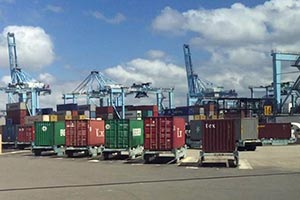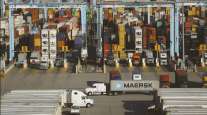Port of Virginia Readies to Take on Savannah

HAMPTON ROADS, Va. — The Port of Virginia is expanding within the next five years in an effort to attract larger vessels traveling through the Panama Canal, according to an Aug. 3 presentation during a sightseeing visit for Congressional staffers and the media.
Port officials will spend $320 million to double the size of the Virginia International Gateway terminal, increasing capacity to approximately 2 million 20-foot-equivalent units, or TEUs. The Port of Virginia is the seventh largest with 2.55 million TEUs handled in 2015, according the American Association of Port Authorities. Of those containers, about 62% end up on trucks, 35% are put on rail and 3% are placed on barges, according to the Virginia Port Authority.
The terminal will also add four new manual ship-to-shore cranes, for 12 total, which take containers off vessels and arrange them to be placed on shuttle carriers.
From there, the cargo either goes to the container yard or on-site rail yard. The project will double the size of the container yard and enlarge the rail operation. CSX and Norfolk Southern both serve the port once a day.
"We’re serious about infrastructure development and creating the capability to handle the volume in Virginia. This is a big deal. This is a game changer," said Shawn Tibbetts, chief operating officer at the port.
The Virginia International Gateway terminal has 15 automated stacking cranes that load containers 5 high by 8 wide. The only human involvement is landing the containers, which is done remotely by an officer with a joystick. Drayage trucks pull into the terminal and a computer assigns them to one of the 15 automatic stacking cranes, which handles the transloading.
When the container yard at the Gateway terminal doubles, the cranes will also double to 30.
The Norfolk International Terminal, located near the Gateway terminal, will get a $350 million investment to expand in two phases. Port officials plan to expand capacity 33% to 2.1 million TEUs from 1.4 million currently.
Phase 1 will convert 15 manual stacking cranes to automatic and copy the layout of the Virginia International Gateway. It should be complete within five years, according to port officials. Phase 2 will add another 15 stacks and cranes, which port officials hope will be complete in the 10 years.
"Our intent is to be the prominent U.S. East Coast gateway. We obviously have New York/New Jersey, who has a very large, captive market, and the big port in Savannah. But we’re in the game and we’re doing the things to elevate our game in Virginia," said Tibbets.
While barges account for a small portion of traffic out of the port, it is big business for the Richmond Marine Terminal, an inland terminal that offers another option for shippers or receivers north of the Virginia capital city.
The barge serves the Richmond terminal Monday, Wednesday and Friday and holds 120 40-foot TEUs, starting in Hampton Roads and making stops in Norfolk, Newport News, Portsmouth and Richmond, which in total takes 12 hours to complete.
Customers at the Richmond Marine Terminal include Scoular Grain, which sells agricultural products, ethanol producer Green Plains Inc. and WestRock Co., which specializes in paper and packaging. Phillip Morris also does business with the terminal and has a cigarette plant less than two miles away.
"The big benefit of the barge is reducing the truck volume on I-64 and I-95 in Virginia and also offering a greener way to move containers," said Patrick Jefferson, general manager of multi-use terminal operations at the Virginia International Terminals, a private company that manages all the terminals for the Virginia Port Authority.
The plans are dependent on port volumes growing year-over-year. The Virginia Port Authority reports that volume handled increased 2.5% this past fiscal year, ending June 30.
Exports grew 4% to 1.41 million TEUs from 1.35 million TEUs the previous fiscal year. Imports grew 1% to 1.16 million TEUs from 1.15 million TEUs the prior fiscal year.
Total rail containers handled increase 10%, but truck containers handled decreased 1% year-over-year. Barge traffic to Richmond increased 15.8%.



